Imagine you were one of the best selling and most widely used chairs in your country. But (hi)story had forgotten you.
Imagine you were informative in context of elucidating important, but rarely illuminated, chapters in the (hi)story of furniture design. But (hi)story had forgotten you.
Imagine you were instructive in context of the practice and craft and industry of furniture design. But (hi)story had forgotten you.
Imagine you were in use in a great many locations. But no-one saw you. No-one knew your name. Just sat on you.
Imagine you were the EW 1192 by Horst Heyder.
With Der ungesehene Designklassiker the Deutsches Stuhlbaumuseum, Rabenau, not only enable one to imagine, but for all begin to redress the situation......
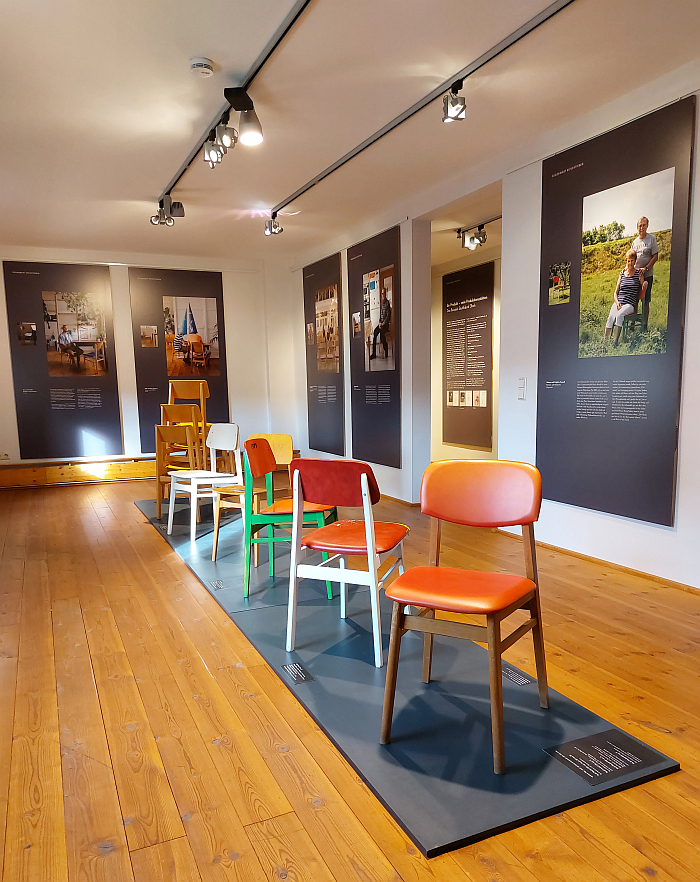
Situated on the side of an improbably steep mountain between Dresden and Chemnitz, Rabenau is extraordinarily proud of its long (hi)story of chair-making, self-confidently proclaiming itself to be the oldest Stuhlbauerstadt, Chair-maker Town, in all of contemporary Germany: the first recorded Rabenau chair-maker being, by all accounts, we weren't there, one Balthasar Wünschmannen in 1674, although he was without question not the only representative of the trade at that time, or as Sachsen's Court Surveyor Adam Friedrich Zürner noted of Rabenau in the early 1700s, "what's remarkable here is that almost all the residents are chair-makers" and that "annually 100 dozen [chairs] are sent to Dresden, Freiburg, Magdeburg, Berlin and Hamburg".1 And while "100 dozen" may not sound a lot, it was the early 1700s, chairs weren't a mass product but still largely a preserve of the wealthy; Rabenau is and was a relatively small town on the side of an improbably steep mountain in a sparsely populated region between Dresden and Chemnitz; we know several popular contemporary manufacturers who would be absolutely delighted, over the moon, to sell "100 dozen" chairs a year. And thus numbers, and the implications that can be read from (hi)story that many of the Rabenau chair-makers specialised in components of chairs rather than construction of complete chairs, something akin with, for example, their 17th and 18th century contemporaries in England who produced the earliest Windsor chairs as a team effort, that very much gives the impression of a near industrial production of chairs in Rabenau in an age before industrial chair production. Industrial chair production in an age before industrial production that also reminds of the (hi)story of Thonet; late-19th century plagiarisms of whose designs abound in the Deutsches Stuhlbaumuseum's permanent collection exhibition. And an industrial production that when it did come not only brought new, quicker, more efficient, production methods but also brought the social, economic and political changes that, amongst other consequences, saw chairs increasingly become the mass product we know today.
And a (hi)story of chair-making in Rabenau, and a (hi)story of the myriad late-19th century Thonet plagiarisms of Rabenau, to which we shall return another day, for our focus here is not that to be found in the Deutsches Stuhlbaumuseum's permanent collection exhibition, fascinating as that all is, but that which isn't to be found there. That chair that wasn't made in Rabenau.
Or at least wasn't according to currently available information, for, as one appreciates while viewing Der ungesehene Designklassiker, The Unseen Design Classic, the EW 1192 is a chair in the process of rediscovery. A chair very much shaking of its anonymity. Very much writing its (hi)story.
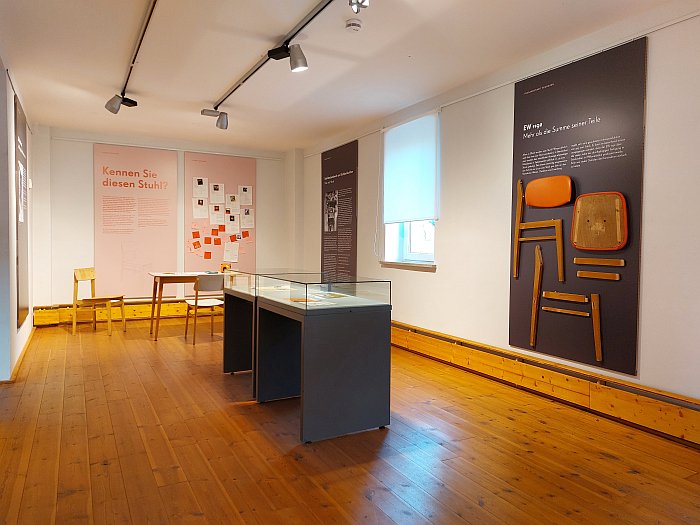
A (hi)story that also begins in the region between Dresden and Chemnitz, if some 50 kilometres west of Rabenau in Waldheim where in 1954 the so-called Entwicklungsbüro Waldheim was established as one of five new institutions realised in context of a programme, initiative, by the DDR government to overhaul not just furniture production and supply, but also interior design, in that, still, fledgling nation. If an initiative, programme, that in the language of its justification and formulation is and was very clearly grounded in the waning light of the so-called Formalism Debate of the early 1950s; that period when the fledgling DDR government, blindly following Stalin's ideological lead, railed against, and loudly rejected, anything and everything associated with the inter-War Functionalist Modernists. A thankfully very short lived moment in the (hi)story of the DDR from which the Entwicklungsbüro Waldheim, in contrast to Mart Stam, appears to have emerged (largely) unscathed. And a Entwicklungsbüro Waldheim that over the decades until its closure against the background of the events of 1989 was responsible for innumerable furniture designs, and a great many furniture innovations, in the DDR, including, and amongst many, many, others, the S 1500 lounge chair, a work in plywood and upholstery that had clearly taken a good long look at the Eames lounge chair, and arguably also at a Yrjö Kukkapuro's Remmi lounge chair, but developed from that study something individual that wouldn't look dated or uncomfortably apologetic at a contemporary furniture fair; the EW 546 lounge chair, a highly incongruous work featuring a bent tubular steel base on top of which is perched an opulently upholstered seat resemblant of a compact interpretation of Adolf Loos's early 1900s Knieschwimmer, and which may be more comfortable and practical than it looks, we certainly hope it is; or the EW 9532, a modular upholstered seating furniture system based around undulating, vaulted, rigid polyurethane base elements into/onto which a variety of seating and table elements can be slotted and fixed. A work which, as can be seen in a 1975 edition of Form+Zweck 2, was a further development in Waldheim of their EW 532, a much more rudimentary modular system; and a EW 9532 that is not only very aware of prevailing positions on and demands of furniture design, but is very forward-looking in its basic premise and argumentation. And has a lightness of character that belies, and resists, the period in which it arose.
Yet an Entwicklungsbüro Waldheim that despite its importance and relevance then, has today all but vanished from the narrative of the (hi)story of furniture design in the DDR.
As has the long time Director of the Entwicklungsbüro Waldheim, and designer of the EW 1192, Horst Heyder.
Born in Dosdorf, Thüringen, in 1924, Horst Heyder trained as a Master Carpenter, and studied at the Fachschule für angewandte Kunst, Erfurt, before being appointed to the inaugural staff of the Entwicklungsbüro Waldheim in 1954, becoming Director in 1962, a post he held until, we presume, his retiral in ca. 1984, but we're not sure about that, the information isn't freely at hand. What we are more certain about is that in context of his tenure in Waldheim Heyder realised a wide variety of designs, and concepts, including, and amongst a great many others, the so-called EW 3156 produced by Aue based Heinz Knorr KG, a.k.a VEB Polstermöbel Aue, which, as best we can ascertain, is and was constructed from individual standardised, very slim, upholstered elements joined together to create a seating unit of freely variable width/length; Luxor for VEB Sitzmöbelwerke Waldheim, essentially an upholstered bucket chair, albeit one with a wonderfully wide, inviting, opening into which to slump, be swallowed, at least apparently we currently only know it from photos; or the so-called Polsterelement EW 506, a modular upholstery system that could enable, if one so will, the creation of freely variable upholstered landscapes and a concept produced by the ever joyously monickered VEB Möbelkombinat Wi-We-Na, the 'Wi-We-Na' being less a children's entertainer as shorthand for Wittenberg-Weißenfels-Naumburg. And the EW 506 a work developed by Heyder together with Rudolf Horn, that other central figure in the (hi)story of furniture and interior design in the DDR. And a EW 506 that very clearly influenced and informed the aforementioned EW 532 and EW 9532. Thereby implying that Heyder had (at least) a hand in the development of the EW 532 and EW 9532, if as part of a wider Waldheim team process.
A contribution to the Entwicklungsbüro Waldheim and to furniture design in the DDR that saw Horst Heyder awarded the inaugural Designpreis of the DDR in 1979, an accolade received alongside Rudi Högner and Horst Michel who as (by then retired) Professors at the Kunsthochshule Berlin-Weissensee and Hochschule für Architektur and Bauwesen Weimar, respectively, were leading figures in the establishment and development of design in the DDR, in the contribution of design to the establishment and development of the DDR. As was Horst Heyder. Or Horst Who as he invariably, and very unfairly, is most popularly received today.
An anonymity that he shares with the EW 1192.
The difference being that while Horst Heyder has actually vanished from view, is actually no longer visible, the EW 1192's anonymity is one lived in full public glare: it being a chair that one can expect to, and does, regularly encounter across eastern Germany, almost as regularly as one finds Adirondack chairs across the eastern USA. Yet a chair which despite its ubiquity, no-one notices. Far less knows the name and biography of. Just sit on.
Regrettably, because as Der ungesehene Designklassiker allows one to better appreciate, the EW 1192 is not only a joyous piece of design, but also highly informative in context of the furniture industry in the DDR. And, arguably, also highly informative in helping us move meaningfully forward towards the 22nd century.
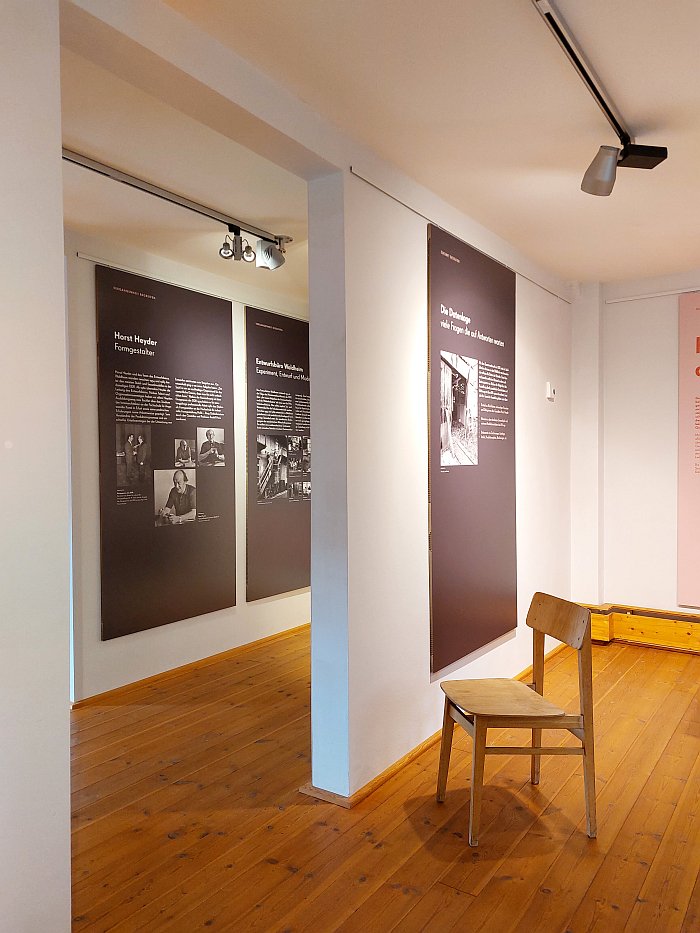
Much as the arrival of industrialisation in the 19th century brought with it social, economic and political change to the region between Dresden and Chemnitz, so to do did the arrival of the DDR, not least through the enforced nationalisation of industry, including of the Stuhlbauer, and general furniture, industry, in Rabenau, and further afield, see, for example the aforementioned VEB Polstermöbel Aue or VEB Möbelkombinat Wi-We-Na, or, and arguably as the best known example, the formation in 1970 of VEB Möbelkombinat Hellerau from the Deutsche Werkstätten Hellerau; once independent manufacturers in a free market now part of a centralised economy and thereby, essentially, dependent on that centralised system, that centralised market, not just for business and raw materials but for products to produce.3
Which is where an institution such as the Entwicklungsbüro Waldheim comes into the story, charged as they were with "Möbeltypen zu schaffen und deren Entwicklung bis zur Nullserie"4, "Devising genres of furniture, and their development to a pilot series"; a task that was, arguably, as much about managing, rationalising, streamlining, the production and supply of furniture in the DDR as it was about designing furniture. And an aspect of the Entwicklungsbüro Waldheim to which we shall return another day.
And a task wherein the use of the term "Möbeltypen " and "Nullserie" is highly informative.
The Entwicklungsbüro Waldheim not only having to design furniture in context of the realities and peculiarities of the DDR economy, for all the financial and material realities and peculiarities; realities and peculiarities, in many regards, not that far removed from those of 1950s and 1960s Denmark, yet while furniture realised in Denmark against the background of the prevailing financial and material realities and peculiarities of the 1950s and 1960s is celebrated at every turn, contemporaneous DDR furniture is (largely) derided and ignored. Or reduced to the hideous ignominy of "Retro".
But also having to design in context of the realities and peculiarities of the DDR manufacturers, those once independent firms who became centralised after the fact rather than as a coordinated, focussed, inherent component of the fact; once independent firms with their own (hi)stories, personalties, skills, specialities, practices and machines. Or as Hein Köster, the long serving Editor of the DDR design magazine Form+Zweck, and one tends to presume a keen observer of the DDR furniture industry, described the situation in 1979: "überall geht es anders zu".5 Things are different everywhere.
Realities and peculiarities that, as one can appreciate when viewing Der ungesehene Designklassiker, are very much embodied in, and expressed by, and elucidated through, the EW 1192.
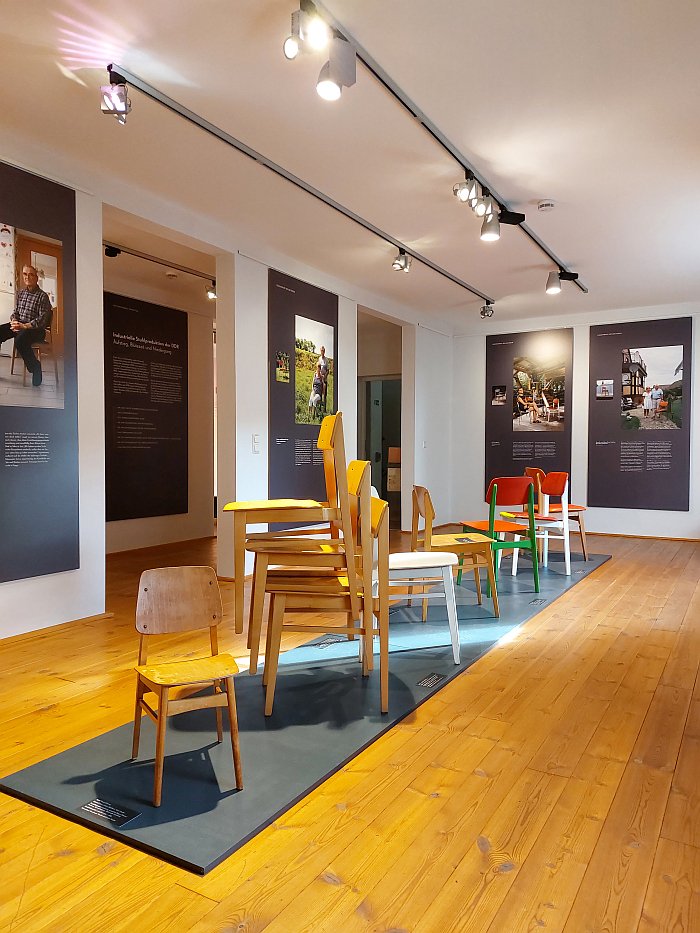
On the one hand the EW 1192 came in a variety of unupholstered and upholstered versions, and at a number of scales suitable for "Kinderzimmer bis Küche" 6, 'kids room to kitchen', and was also an object suitable for, and employed in, both private domestic and public contract spaces, was a true multi-purpose chair; and thus stood, stands, as much as a family of chairs, as a universal chair programme, as a Möbeltypen, as it as an actual chair. And a variety of use from one concept that tends to locate the EW 1192 as an expression of Horst Heyder's demand for "Standardsortimente", standard ranges, rather than innumerable individual solutions in the supply of furniture.7 A demand that, arguably, was based more on economic and efficiency considerations than any design position.
On the other hand the EW 1192 is a deliciously reduced and rational design, an object that is as visually and conceptually light as it is material light. A design principle, inarguably, associated with the realities and peculiarities of the DDR: material availability and quality often being the defining factor. See also Denmark. But also a design principle which not only allowed the chair be used in compact spaces without, apparently, taking up to much room, nor only responded to the need to quickly produce large numbers of a stable, sturdy, variable chair, but a principle whose foundation, reasoning, can be followed in Horst Hedyer's positions on, and approaches to, design, including his opinion that, "every ideation is preceded by considerations about the correct and sensible use of materials", and that in the design process, "it's not just about [developing] a different form, but always about [developing] better production and use, about a better use of materials".8 Positions and approaches that have, inarguably, become increasingly relevant in recent years, for all as we've all began to accept the finiteness of all materials. Positions and approaches that will, arguably, remain incredibly relevant. And where the idea of developing better "use" is one all too rarely discussed in the furniture and furniture design industries. How does one develop better "use" in context of a chair design?
And on the rare, and thus particularly valuable, third hand, whereas, as best we can ascertain, the greater majority of the Entwicklungsbüro Waldheim's designs were produced by a single manufacturer, were arguably designed for the DDR furniture industry as a whole, but with a particular manufacturer very much in mind and who subsequently became the sole producer, we're conjecturing now, we don't know for certain, that's our understanding; we do know the EW 1192 was produced at numerous locations throughout the DDR, the research for the Der ungesehene Designklassiker having unearthed 6 locations, possibly 7: Waren, Oederan, Benneckenstein, Ellrich, Eisenberg, Erfurt and, possibly, Haldensleben, thus locations across Thüringen, Mecklenburg-Vorpommern, Sachsen-Anhalt and Sachsen. However no one would be surprised if more production locations are unearthed. Hopefully in Berlin and Brandenburg. That would be cool.
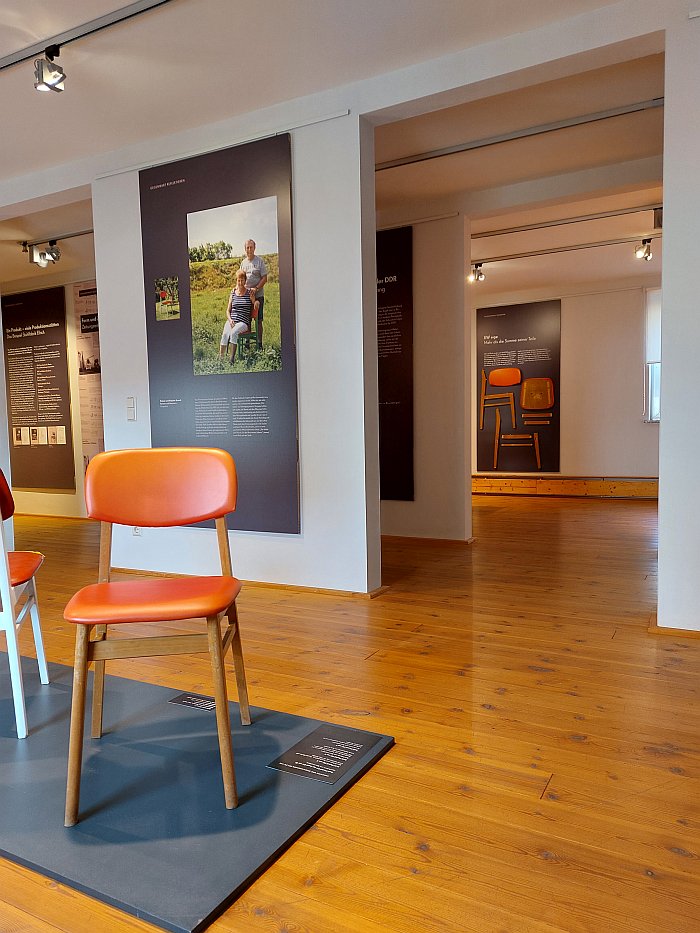
A variety of production locations that, arguably, is and was related to the sheer volume of EW 1192s produced; whereas elsewhere in the DDR shortages and waiting times were the norm, the EW 1192 was turned out on a prodigious scale that would have greatly impressed the highly industrious 18th century Rabenau Stuhlbauern: Der ungesehene Designklassiker — and again with the proviso that it is still a (hi)story being written, there is still a lot of information to be unearthed — roughly estimating an annual production of around 325,000 chairs, some 27,000 dozen annually to remain in an Adam Friedrich Zürner's vocabulary, which means that over the decades of its production, potentially, possibly, more than 5 million EW 1192s were produced.
Numbers which, in context of the differing contexts, rival, if not surpass, the much quoted, and equally thoroughly unproven, thoroughly unprovable, global sales figures for the Thonet 14 before 1939. And numbers which mean that when the DDR ended there may, potentially, possibly, have been one EW 1192 for every three DDR citizens. Which is a phenomenal chair density by any standards. If, as we say, the numbers are at the moment pure conjecture. Could be very wrong. Could also be an underestimate. No-one knows for sure.
And while a great many of those EW 1192s were lost, disposed of, burnt, in the 1990s, the EW 1192 remains ubiquitous. And still remains physically sound. And still elegantly and effortlessly and supremely comfortably fulfils and performs that function for which it was intended. Which inarguably is one of the reasons for the ubiquity. And testament to the inherent quality of design and realisation. And also an excellent reminder that life-cycle and durability are important factors in any and all assessment of ecological and economic sustainability. It's not all about your wood certification. It's also about how much wood you use replacing perfectly good chairs. And how much wood you reject because of a light blue colouration.
And a variety of production locations that also employed the centralised nature of the DDR furniture industry to increase the economic and ecological efficiency of chair supply; employed the control and management inherent in the decentralised basis of the centralised economy to mass produce a single product at numerous locations, and thereby avoid, reduce, the costs and resource usage of national distribution from a single production centre. Or as Hein Köster sagely notes "distributing plans is cheaper than transporting finished products".9 A position that while true also demands a well thought through and conceived design, a design that can be produced at numerous locations regardless of the specific skill sets at each and without vast investment at each. A design that appreciates and accepts that "überall geht es anders zu". Something the EW 1192 inarguably represents. And a position that, we'd argue, is very relevant in context of our contemporary digital production methods, the much vaunted, if still only slowly approaching, Industry 4.0, and the possibilities for the furniture industry inherent in distributing 3D print or CNC milling files and thus a move from centralised to decentralised production.
And a variety of production locations that also meant that each production location realised the EW 1192 in their own way, "überall geht es anders zu": while all manufacturers had the same 'plans' they had their individual characters. As did their EW 1192s.
A state of affairs that can be viewed and studied in Der ungesehene Designklassiker via a presentation of half a dozen EW 1192s of various typologies and, importantly, differing constructions; works which although essentially similar, the mortise and tenon joints, for example, are ever present, the stretchers are in the same locations, the proportions and internal relationships are largely the same, vary in terms of, for example, the manner in which the seat is fixed to the frame, or the connection of the backrest. Variations that, reading between the lines, one very much gets the impression were expected, it was understood that "überall geht es anders zu", but as long as the end result met the required quality standards, why not.
Or put another way, for all the EW 1192 was a product, it can also be considered a "Nullserie". A basic concept, rather than a fixed thing.
Which, again, allows the EW 1192 to contribute to discourses on the future of the global furniture industry. And on our relationships to industrial production. Why we want industrial production. What we expect, and demand, from industrial production. How we define industrial production. And must industrial production always produce exact replicas? Or is it about producing required volumes of meaningful, durable objects?
A bijou showcase which (primarily) introduces and explores the EW 1192 through posters elucidating the current state of the research, the current state of the writing of the (hi)story of a chair whose (hi)story should be popularly known, but which isn't, posters backed up by archive documents, photos and the aforementioned variations on the EW 1192, a central, and very pleasing, component of Der ungesehene Designklassiker is examples of the EW 1192 in use: a presentation of some nine EW 1192 biographies as told by those humans who use them on a daily basis, by those humans who do see the EW 1192.
Biographies told by, for example, the Landeskirchlichen Gemeinschaft in Lauter-Bernsbach, near Aue, whose 40-ish EW 1192's were threatened with being replaced, disposed, on account of their non-stackability, before carpenter Dietmar Gundermann further developed, transformed, them in to stackable chairs, thereby extending their life through extending their functionality, the EW 1192 as a Nullserie; by Rainer and Brigitte Brandl from Klingenthal on Sachsen's southernmost border, whose 1971 acquired EW 1192 has been through numerous lives, including as a kitchen chair, as a workshop chair, and today, having survived through sheer strength of will attempts to dispose of it post-1989, as a garden chair, and thus helping underscore the inherent flexibility, and for all durability, of the work; or by the Kunstgewerbemuseum Dresden who thanks to the research behind Der ungesehene Designklassiker now have a EW 1192 in their collection. Whereby it was always in the museum, but in use on a daily basis as a chair, not catalogued and standing on a shelf in their archive as a chair. And which is not only a wonderful example of the ubiquity of the EW 1192, the fact one can and does meet them regularly without anyone, not even art and design historians, knowing on what they are sitting, but is also well worth reflecting on and considering in context of what the Kunstgewerbemuseum's Klára Němečková told us from German Design 1949–1989. Two Countries, One History at the Kunsthalle im Lipsiusbau, Dresden about (former) DDR citizens not believing the DDR's objects of daily use are, were, important cultural artefacts. That devaluing of 'Soviet' era artefacts by citizens of the former West and the former East that, as discussed from Retrotopia. Design for Socialist Spaces at the Kunstgewerbemuseum, Berlin, has so fundamentally contributed to skewing appreciations of late 20th century design in Europe, led design from western Europe to be placed much higher than that from eastern Europe, led to the Ten Principles of a Dieter Rams to be placed so much higher than the Five Big Ls of a Karl Clauss Dietel. And, invariably, one of the reasons so many EW 1192s have been thrown away and burnt since 1989. Why hold on to a wooden chair from the DDR when there are exciting new chairs to be had?
Der ungesehene Designklassiker has a few very good arguments why.
Arguments reinforced by an EW 1192 on which you can sit, a particularly satisfying aspect of the Der ungesehene Designklassiker not only because that is exactly what chairs exist for, sitting on not looking at on pedestals, and a sitting that allows one to experience for yourself the comfort and security of the EW 1192; but also satisfying because not placing it on a pedestal is an open invitation to get up close and personal with it, to view it from a wide variety of angles, to fully engage with it, to study its construction, its character, to appreciate what makes it the chair it is physically, conceptually, design (hi)storically, and then to compare the DDR era EW 1192 with the contemporary re-design by Leipzig based designer Jacob Strobel, to.......
....... ¿wait?........ ¿wait?....... ¿contemporary re-design?
¿????
¿Can one re-design a chair such as the EW 1192?
¿May one re-design a chair such as the EW 1192?
¿????
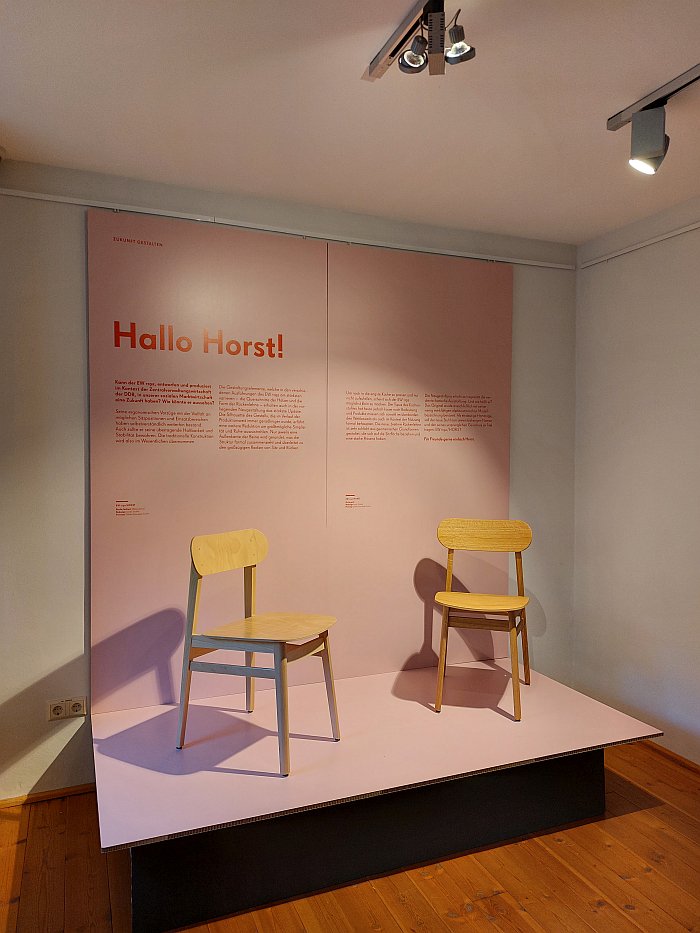
¿????
A question to which we shall return to very, very shortly. Save to note here.... no, no, stop, no spoilers. We'll all just have to wait.
For all that Der ungesehene Designklassiker is about the EW 1192, the nature of the presentation also allows for an effortless, self-evident, and very pleasing, introduction to both Horst Heyder and the Entwicklungsbüro Waldheim, introductions that allow them both to begin to achieve the visibility, and acquire the recognition, they inarguably deserve but are currently unfairly denied; and introductions which very much demand further action, further research. And also elegantly provides for differentiated access to the (hi)story of furniture design in the DDR; allows for the beginnings of a more probable popular narrative of the (hi)story of furniture design in the DDR, taking one as it does beyond the easy cliches and poorly substantiated myths.
And in many regards it is not only appropriate, but important, that it should be the EW 1192 that opens up that access and narrative, not only because it was such a widely used chair in the DDR, nor only because of its many associations with the practicalities and machinations of the DDR furniture industry, but primarily because it is a simple wooden chair, thus a member of that genre of chairs that amid all the fuss and fireworks, and objectification, of bent steel and plastic chairs it can be all too easy to forget have long been by far the most important works in context of everyday reality. Are the chairs that can and do tell the mundane (hi)story that we all need to hear if we're to properly appreciate the paths thus travelled. And not the fanciful legends of those paths that tend to abound and prevail.
Thoughts on the (hi)story of furniture as primarily a (hi)story of anonymous wooden chairs, whereby we return again to a Thonet who in the 1920s and 30s sold a lot more wooden chairs that tubular steel chairs, one thinks, for example, of the B 1, their version of the so-called "Frankfurter Chair" genre....... thoughts on the (hi)story of furniture as primarily a (hi)story of anonymous wooden chairs initiated by the EW 1192 which mean the Der ungesehene Designklassiker is also an invitation to question the "Designklassiker" of its title. A presentation that demands one question what is a design 'classic'. A word that in terms of furniture is regularly, and very lazily, thrown about, invariably in context of those ubiquitously repeating chair designs that appear in any and ever overpriced furniture design coffee table book, and examples of which all relevant museums have in their collections, and invariably are to be found in the permanent exhibition, thereby underscoring their importance as 'classics'. But what is a 'classic'? How are we defining 'classic'? Who is defining 'classic'? When did they last define 'classic'? Why do we define 'classic'? And what are those works that aren't 'classic'?
The EW 1192 can make an awful lot of claims. But is it a 'classic'? Should it be a 'classic'? Does it need to be a 'classic'? Does it want to be a 'classic'? Does it not just need to be understood, appreciated and discussed? Does it not just need to be understood, appreciated and discussed as a component of the narrative of the (hi)story of furniture design? To be understood, appreciated and discussed as an informative, reliable, openly communicative, eyewitness of the DDR and the DDR furniture industry? While being sat on. It is, after all, a chair.
Given the depths to which not only the EW 1192 fell post-1989, but to which all cultural artefacts of the DDR fell, or at least those that couldn't be cynically marketed by the repugnant peddlers of toxic Ostalgie, the path towards that position once seemed as improbably steep as the mountain on which Rabenau stands;10 Der ungesehene Designklassiker makes that ascent a lot less daunting. For although as a showcase Der ungesehene Designklassiker can do no more than introduce the EW 1192, and that not least because, as noted above, there is still a lot to be rediscovered, still a lot of the (hi)story of the EW 1192 to be retold, written, through the open, sober, grounded manner in which it invites one to approach the EW 1192 and the contexts in which it arose and vanished, through the considerations and reflections it stimulates and demands, Der ungesehene Designklassiker allows one to begin to perceive a moment in the not too distance future when we all see the EW 1192, when we all know the EW 1192 by name, all know the biography of the EW 1192, when the EW 1192 retakes its place on the helix of furniture design (hi)story.
Imagine that.......
Der ungesehene Designklassiker is scheduled to run at the Deutsches Stuhlbaumuseum, Lindenstraße 2, 01734 Rabenau until Sunday March 3rd.
1One meets the quote by Adam Friedrich Zürner everywhere in context of Rabenau, but never with a reference. We're still trying to track it down, if and when we do, we'll update.......
2Jürgen Klepka, Sitzen in der Reihe, Form+Zweck, Vol. 7, Nr. 3, 1975, 14-15 And as ever at this juncture a million and one thanks to the glorious people at the Sächsische Landesbibliothek – Staats- und Universitätsbibliothek, SLUB, Dresden for digitalising Form+Zweck as full text OCR and making them freely available. An example a great many other libraries and archives need to follow, it's what the internet and digital technology is there for.....
3We're generalising dangerously here, sorry! But necessarily so. Alongside the centralised design institutions there were also company internal design teams and the odd freelancer such as, for example, Karl Clauss Dietel. However one must also remember that everything had to be centrally approved before being produced, you couldn't just produce what you wanted, and you were also dependent on being supplied the necessary materials. And so in that regard firms were dependent on the centralised system. We're also greatly simplifying the economic and industrial and commercial systems and realities in the DDR, again apologies, but that's way to complicated a subject for this occasion. Read up on it all yourselves......
4Dokumente und Materialien der 150. Sitzung der Regierung der DDR von 21. Jan. 1954, Beschluß über die neuen Aufgaben der Innenarchitektur und der Möbelindustrie, in BArchiv DC 20-I/3/213 The here quoted passage isn't directly related to the Entwicklungsbüro Waldheim is rather a general statement of intent and purpose, but the Entwicklungsbüro Waldheim very much took up that part of the plan, and thus, we'd argue, is very much indirectly meant.
5Hein Köster, Die Erste Jahre, Form+Zweck, Vol. 11, Nr. 5, 1979 page 19
6Erfahrung [Horst Heyder in conversation with Hein Köster] Form+Zweck, Vol. 11, Nr. 5, 1979 22-24
7Ibid
8Ibid
9Hein Köster, Die Erste Jahre, Form+Zweck, Vol. 11, Nr. 5, 1979 page 19
10There are a great many ways to reach the Stuhlbauermuseum we took the most entertaining: the steam train from Freital-Hainsberg. But then you have a very, very, very steep climb up to Rabenau. It's a very well laid out and designed and constructed path, a nice stroll with lots to see and do, but vertical in places. We're not joking, vertical.
Full details can be found at https://deutsches-stuhlbaumuseum.de (German only)